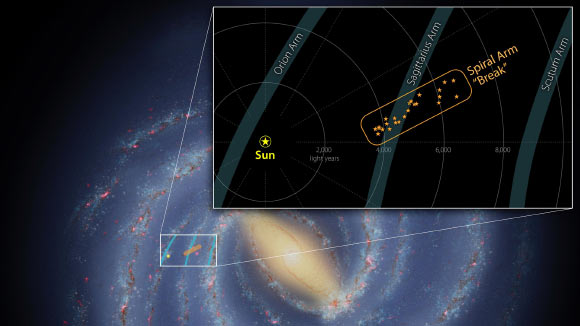Astrophysicists have mapped the 3D locations and velocities of star-forming regions in a segment of the Sagittarius arm using data from NASA’s Spitzer Space Telescope and ESA’s Gaia mission.

Stretching 3,300 light-years, a collection of young stars and star-forming clouds in the Sagittarius arm of our Milky Way Galaxy is the first major structure identified with such a dramatically different orientation relative to an arm. The background image shows the location of the splinter in the Milky Way. The yellow region in the center of the image is the Galaxy’s bright and crowded center. The Milky Way’s arms spiral around the center, and are full of stars and star-forming clouds of gas and dust. The inset provides a closer view of the structure, as well as its size and distance from the Sun. The nearby spiral arms are also noted. The star shapes indicate a star-forming region that may contain anywhere from dozens to thousands of stars. These stars and star-forming regions are moving through space together, at roughly the same speed and in the same direction. Image credit: NASA / JPL-Caltech.
“Most of our understanding of spiral arms comes from observations of other galaxies, where our outside perspective allows us to see the full spiral structure,” said Caltech astrophysicist Dr. Michael Kuhn and colleagues.
“In these other galaxies, spiral arms often have smaller-scale structures, including spurs (luminous stellar features) and feathers (dust features) that extend from arms to inter-arm regions, as well as branches in the main arms.”
“In the Milky Way, it has been more challenging to disentangle such features owing to our perspective within the highly extincted disk.”
To learn more, the astronomers focused on a nearby portion of one of the Galaxy’s arms, called the Sagittarius arm.
“In the current picture of the Milky Way, the Sagittarius arm is the closest major spiral arm inward from the Sun and hosts several prominent, nearby massive star-forming regions,” they said.
Using NASA’s Spitzer Space Telescope, they sought out newborn stars and nebulae, which are thought to align closely with the shape of the arms they reside in.
To get a 3D view of the arm segment, they used the latest data release from ESA’s Gaia mission to measure the precise distances to the stars.
The combined data revealed that the 3,300-light-year-long structure associated with the Sagittarius arm is made of young stars moving at nearly the same velocity and in the same direction through space.
The structure contains at least 25 star-forming regions such as Messier 8, Messier 16, Messier 17, and Messier 20.
“A key property of spiral arms is how tightly they wind around a galaxy,” Dr. Kuhn said.
“This characteristic is measured by the arm’s pitch angle. A circle has a pitch angle of 0 degrees, and as the spiral becomes more open, the pitch angle increases.”
“Most models of the Milky Way suggest that the Sagittarius arm forms a spiral that has a pitch angle of about 12 degrees, but the structure we examined really stands out at an angle of nearly 60 degrees.”
The findings appear in the journal Astronomy & Astrophysics.
_____
M.A. Kuhn et al. 2021. A high pitch angle structure in the Sagittarius Arm. A&A 651, L10; doi: 10.1051/0004-6361/202141198







